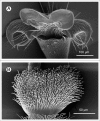The insect-trapping rim of Nepenthes pitchers: surface structure and function
- PMID: 20009546
- PMCID: PMC2819508
- DOI: 10.4161/psb.4.11.9664
The insect-trapping rim of Nepenthes pitchers: surface structure and function
Abstract
Carnivorous pitcher plants of the genus Nepenthes capture prey with a pitfall trap that relies on a micro-structured, slippery surface. The upper pitcher rim (peristome) is fully wettable and causes insects to slip by aquaplaning on a thin water film. The high wettability of the peristome is probably achieved by a combination of hydrophilic surface chemistry, surface roughness and the presence of hygroscopic nectar. Insect foot attachment could be prevented by the delayed drainage of the thin water film between the adhesive pad and the surface. Drainage should be faster for insects with a hairy adhesive system; however, they slip equally on the wet peristome. Therefore the stability of the water film against dewetting appears to be the key factor for aquaplaning. New experimental techniques may help to clarify the detailed function of the pitcher plant peristome and to explore its potential for biomimetic applications.
Figures




References
-
- Ellison AM, Gotelli NJ. Energetics and the evolution of carnivorous plants—Darwin's ‘most wonderful plants in the world’. J Exp Bot. 2009;60:19–42. - PubMed
-
- Kato M, Hotta M, Tamin R, Itino T. Inter- and intra-specific variation in prey assemblages and inhabitant communities in Nepenthes pitchers in Sumatra. Trop Zool. 1993;6:11–25.
-
- Moran JA. Pitcher dimorphism, prey composition and the mechanisms of prey attraction in the pitcher plant Nepenthes rafflesiana in Borneo. J Ecol. 1996;84:515–525.
-
- Clarke CM. The effects of pitcher dimorphism on the metazoan community of the carnivorous plant Nepenthes bicalcarata Hook. f. Malay Nat J. 1997;50:149–157.
-
- Adam JH. Prey spectra of Bornean Nepenthes species (Nepenthaceae) in relation to their habitat. Pertanika J Trop Agric Sci. 1997;20:121–134.
Publication types
MeSH terms
Substances
Grants and funding
LinkOut - more resources
Full Text Sources
Other Literature Sources
Molecular Biology Databases
